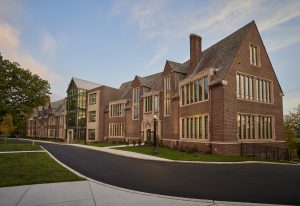Revitalizing STEM Education

In response to the growing interest in science, technology, engineering, and math (STEM) subjects, The Hill School recognized the need for a substantial upgrade to its existing science center. The center required a renovation and integration within the campus to cater to its evolving educational needs.
This understanding led to the formation of a dedicated committee that embarked on a year-long journey to research and design a new Quadrivium Curriculum and a STEM education center. The school aimed to foster an environment that promotes student growth in STEM fields, emphasizing independent learning, adaptability, and collaboration.
Preservation Meets Modernization
The comprehensive project entailed the complete renovation of two existing buildings and the creation of a “link” for seamless connection. Structural updates were made to the existing buildings to accommodate the new addition and layout. This process involved underpinning and integrating new steel and blocks to create openings for the “link.” A crucial aspect of this project, the “link,” facilitated easy access between the structures and was constructed from preserved and salvaged historic limestone.
Great care was taken during the exterior renovations to preserve the historic fabric of the buildings. This included repairing the slate roof and restoring the brick and limestone masonry. The interior of the project highlighted a harmonious blend of preservation and modernization. Historic elements such as limestone arches, brick façade, and wood paneling were meticulously restored. At the same time, modern features like state-of-the-art lab equipment were integrated, providing an enhanced learning environment. A complete Mechanical, Electrical, and Plumbing (MEP) overhaul was also undertaken.
The project necessitated alterations to the campus layout, which included new paving, curbing, sidewalks, site lighting, landscaping, and modifications to nearby parking lots. These efforts resulted in a unified, historic structure now serving as a new focal point on campus.
Building on an Occupied Campus
Several challenges arose during construction, including building on an active, fully operational academic campus with faculty, staff, students, and visitors in close proximity. This required meticulous safety measures, logistical planning, and coordination throughout the project’s duration. The COVID-19 pandemic introduced another layer of complexity, impacting the campus and posing challenges to the project’s schedule and budget. Despite these hurdles, close coordination and scheduling were employed to manage the subcontractors and the fluctuating workload, ensuring that productivity levels were met.
Navigating Unforeseen Challenges
A surprising element faced during construction included the unexpected need to excavate 127 cubic yards of rock. The team faced this head-on by ensuring it did not affect the project schedule. The confined space of an underground tunnel posed another challenge, requiring special work for steam and utility installations. Despite these constraints, the team’s proactive approach, including daily huddles, safety meetings, and constant communication, ensured the successful completion of the tunnel work without any schedule delays. The additions and renovations to the Shirley Quadrivium Center were executed with a dual focus: aligning with The Hill School’s vision for future generations of students while preserving the historical buildings’ past.


